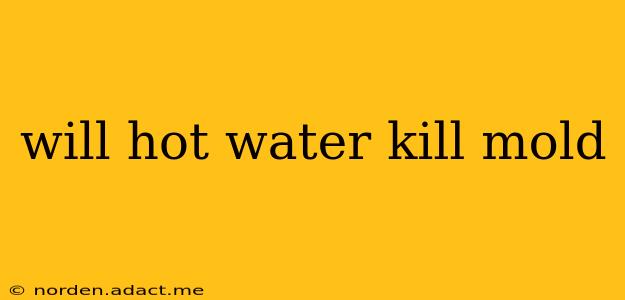Will Hot Water Kill Mold? A Deep Dive into Mold Remediation
Mold. The very word conjures images of damp basements, musty smells, and potential health hazards. Discovering mold in your home is understandably alarming, and many homeowners immediately reach for the quickest solution they can think of: hot water. But will hot water kill mold? The answer, unfortunately, isn't a simple yes or no. Let's explore this question thoroughly.
While hot water can damage mold and even kill some spores, it's rarely a sufficient solution for complete mold removal. It's crucial to understand the limitations of using hot water as a primary mold remediation method.
What Happens When You Use Hot Water on Mold?
Hot water, especially at boiling temperatures, can denature the proteins in mold cells, effectively killing them. However, this is only effective for surface mold, and even then, it's not guaranteed to eliminate all traces. The problem lies in the nature of mold itself.
Mold is a complex organism that spreads via microscopic spores. These spores can easily penetrate porous materials like drywall, wood, and insulation. Hot water simply won't penetrate deeply enough to reach these embedded spores, leaving them alive and ready to reproduce once conditions become favorable again. Furthermore, cleaning with hot water might disperse the spores, potentially spreading the mold problem to other areas.
What Temperature of Water Kills Mold?
There's no magic temperature that guarantees mold eradication. While boiling water (212°F or 100°C) can kill many mold cells on contact, the crucial factors are contact time and thoroughness. Even at boiling point, a brief exposure won't be effective. Prolonged exposure to high temperatures is necessary, which isn't practical or safe in most household situations.
Is Hot Water Enough to Get Rid of Mold?
No. Hot water alone is generally insufficient for effective mold remediation. While it can be a helpful part of the cleaning process after mold has been professionally removed, it shouldn't be relied upon as a primary method. It's much more effective to combine hot water with other cleaning agents and thorough drying.
What are the Best Methods for Mold Removal?
The most effective approach depends on the extent of the mold infestation. For small areas of surface mold, a solution of bleach and water (follow product instructions carefully) can be effective, followed by thorough rinsing and drying. For larger infestations or mold penetration into structural materials, professional mold remediation is essential. Professional mold removal services employ advanced techniques and equipment to safely and thoroughly remove mold, addressing the source of the problem and preventing future growth.
What Should I Do If I Find Mold in My Home?
- Identify the source of moisture: Mold thrives in damp environments. Find and fix leaks, improve ventilation, and address any humidity issues.
- Assess the extent of the problem: Is it a small patch of surface mold, or is it a more extensive infestation?
- Protect yourself: Wear protective gear, including gloves, a mask, and eye protection when cleaning up mold.
- Clean small areas yourself (with caution): Use appropriate cleaning solutions and follow safety guidelines.
- Call a professional for larger infestations: Don't attempt to tackle extensive mold growth yourself; professional remediation is safer and more effective.
In conclusion, while hot water might kill some surface mold, it's not a reliable or complete solution for mold remediation. A comprehensive approach, which may include professional help, is necessary for effective and safe mold removal. Remember, preventing mold growth is always the best strategy. Maintain good ventilation, address moisture issues promptly, and regularly inspect your home for signs of mold.
